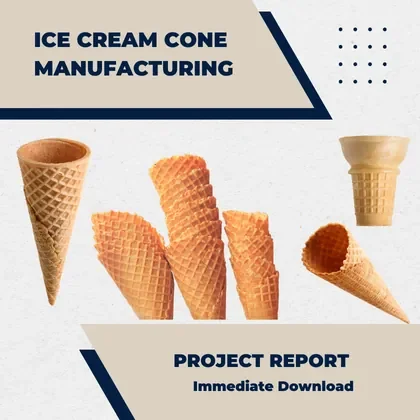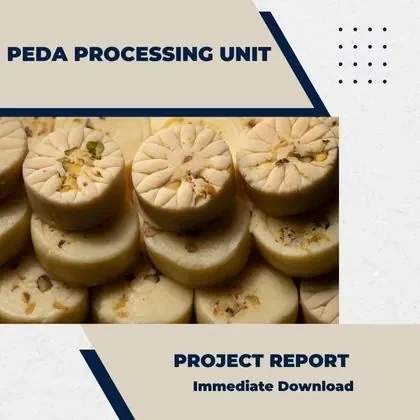Description
If you are interested in understanding the Khoya Manufacturing industry, you can download the project report from the website.
As an animal carbohydrate, protein, and fat, milk plays a significant role in the vegetarian diet of Indian food. Due to the greater air temperatures in the Indian subcontinent, ancient Indians created more stable dairy products to keep their nutritious qualities. Khoya is a key component of indigenous dairy products, as it is used to make a variety of sweet treats. Khoya is a common product in India, where it is known by several names such as khoya, mawa, kava, pavlova, and so on. Khoa is a whole milk concentrate made by condensing milk in a pan. The Food Safety and Standard Regulations of 2011 define khoya as a product prepared from cow, buffalo, goat, or sheep milk, milk solids, or a quick-drying combination and sold under the names Pindi, Danedar, Dhap, Mawa, or Kava.
Khoya is used to make around 80% of Indian sweets. Aside from that, khoya is also used to make halwa and ice cream. Everyone in India loves sweets; thus, a sweet store is quickly found on each tiny street. Khoya is a must-have ingredient for making pure sweet khoya, manufactured by boiling milk. Confectioners still create khoya by hand; however, some machines can produce khoya on a large scale. If you have enough money to invest, establish a khoya-making firm with just a single khoya machine and meet your city’s demand.
Method and purpose of downloading Project Report of Khoya Manufacturing
Table of Contents
- 1 Method and purpose of downloading Project Report of Khoya Manufacturing
- 2 Market Survey & Business Plan
- 3 Market Potential
- 4 Topics covered in Khoya Manufacturing’s project report.
- 5 Product Uses
- 6 Product Raw Material
- 7 Raw Material Costs
- 8 Space Needed
- 9 Manufacturing Process
- 10 Plant & Machinery
- 11 FAQ’s
Following are the main objectives of preparing the project report of Khoya Manufacturing.
- To acquaint the new entrepreneur with the various economic, technical and financial aspects of a business.
- To help in the preparation of project report of bank loan for business.
- Help in decision making regarding investment in the business of Khoya Manufacturing.
The project report is available on the website for download in PDF format. You can get the project report in pdf format by paying the prescribed fee.
Market Survey & Business Plan
Before launching a khoya manufacturing company in your region, you must do a market survey and make a project report.
- What is the market demand for khoya?
- Where can you sell khoya after you’ve made it?
- How many sweet stores do you have in your neighbourhood?
- How much khoya does each of these sweet stores consume daily?
- Is there a large number of khoya vendors on the market?
You may contact all of the khoya-using shops within a 5-kilometre radius of you. Please find out how good they are and how many there are. This will help you figure out what type of strategy you want to put together.
In the market, there are many different varieties of khoya. Because the khoya available is of poor quality, the shopkeeper must trust you to give the finest grade of khoya for you to attract him.
Market Potential
India has the world’s most significant bovine population. However, compared to other major dairy producers, milk production per animal is much lower. Furthermore, practically all dairy products are eaten domestically in India, with the bulk being sold as fluid milk. As a result, the Indian dairy sector has enormous value-adding and overall development potential. In terms of market size, growth, pricing, segmentation, co-operatives, private dairy, procurement, and distribution, the Indian milk industry is expected to reach 11,360 billion INR by 2020. In India, the milk industry is a tool for socio-economic development and a lucrative financial opportunity. As a result, the Indian government has created several plans and measures to help the country’s dairy sector grow.
Private engagement in the Indian dairy business, on the other hand, has risen in recent years. The milk sector enters both national and international firms, drawn by the size and potential of the Indian market. The focus is on valuable items such as cheese, yoghurt, probiotic drinks, etc. They are also developing unique items that are tailored to the needs of Indian consumers. These firms are also increasing their milk procurement network, aiding the dairy industry’s expansion in India. Further, the Indian dairy sector is predicted to increase over five years.
Topics covered in Khoya Manufacturing’s project report.
The business project report of Khoya Manufacturing highlights the following topics.
| Sr. No. | Particulars |
| 1 | Introduction |
| 2 | Market Potential |
| 3 | Product Description |
| 4 | Product Uses |
| 5 | Product Raw Material |
| 6 | Manufacturing Process |
| 7 | Flow Chart Of The Process |
| 8 | Project Components |
| 9 | Land & Building |
| 10 | Plant & Machinery Details With Images |
| 11 | Miscellaneous Assets |
| 12 | Power Requirement |
| 13 | Manpower Requirement |
| 14 | Cost Of Project |
| 15 | Means Of Finance |
| 16 | Projected Profitability Statement |
| 17 | Projected Balance Sheet |
| 18 | Cash Flow Statement |
| 19 | Calculation Of D.S.C.R |
| 20 | Production & Yield |
| 21 | Sales Revenue |
| 22 | Salary, Wages & Power Requirement |
| 23 | Working Capital Requirement |
| 24 | Depreciation |
| 25 | Repayment Schedule Of Bank Loan |
| 26 | Break Even Point Analysis |
| 27 | License & Approvals |
| 28 | Assumptions |
Product Uses
Khoya, also known as mawa or Khoa, is evaporated milk solids that have been dried. Mawa is the base for practically all desserts in Indian cuisine, especially in the north. Khoya is mostly utilised in the preparation of a range of desserts. It’s also used to make payasam and a kind of halva.
Product Raw Material
Milk is the sole raw material necessary for a Khoya production unit, and it is readily accessible in the local market. The quality of the milk determines the quality of the khoya. One kilogramme of milk with 8% fat content yields 400 to 500 grammes of khoya. 300 gm fat is obtained from 6% fat.
Raw Material Costs
The cost of milk varies by region, but buffalo milk costs between Rs. 50 and Rs. 60 per litre, whereas cow’s milk costs between Rs. 40 and Rs. 50 per litre. These prices include packet milk. This company can be established with package milk if the cow or buffalo does not produce milk.
Space Needed
A total of 450 square feet is required to begin this business. The machine can run on 5 volts, but you’ll need somewhere to keep the milk. Apart from being lost, there should be a location where may keep it. You may begin with 10 X 10 Square Fit. After that, as your company grows, you will be able to take on more space.
Manufacturing Process
The Khoya manufacturing process is shown below and detailed information is available in the project report along with flow chart. You must download the report and study it.
- Raw milk is delivered to the processing facility after being collected from various milk collection units.
- The collected milk is pasteurised to avoid milk deterioration to eradicate microbial and other contaminants.
- This milk is now moved to the bulk chiller, where it will be cooled to 4°C and kept fresh.
- In the jacketed kettle, 100 litres of standard cow milk with 4.5 per cent fat or 80 litres of standardised buffalo milk with 5.5 per cent fat are taken in batches and heated to a boil.
- A double jacketed kettle, steam-heated pan, or kettle is used to control the healing process and non-smoking heating better.
- To avoid burning milk solids, the bottom and sides of the kettle are scraped, and the milk is forcefully stirred with a stainless steel stirrer while it is boiling.
- Milk boiling is done at a pressure of about 2 kg/cm2.
- Slow heating is essential when the milk reaches the rabri stage to avoid particulates burning on the top, discolouration of the product, developing roasted flavour and rigid body, and coarse texture.
- During the last stages of the process, the stirring rate is likely to be raised to achieve a high-quality result.
- When the finished product begins to cling together, it is ready.
- The heating is turned off when the product begins to leave the edges of the kettle and gathers in the centre.
- A batch of Khoa takes roughly 20-25 minutes to produce using this approach (20 kg).
- The Khoa is now ready to be packaged, marketed, and processed further.
Plant & Machinery
- Milk reception system
- Bulk chiller
- Milk Pasteurizer
- Khoya Making Machine
- Vacuum packaging machine
- Lactometer
- Boiler
- Milk Analyser
- Industrial milk Pump
- Material handling and other types of equipment.
The detailed information of Khoya Manufacturing’s Plant & Machinery are in the project report with pictures. For detailed information you can download and study the project report.
Marketing
You can get in touch with a wholesaler in your region. Also, you can contact confectionery shops within a 5-kilometre radius. You won’t need to go anyplace else if you call 10 to 20 sweet stores.
You may start a company selling Khoya, cheese, milk, and yoghurt by opening your shop. As a result, milk prices will be lower and profit margins will be bigger.
FAQ’s
What is the best place to get raw materials?
You can contact the neighbouring community for large quantities of milk. You might also call any dairy in your area. We can also use packaged milk, but it will be more expensive and result in less profit. You may also create khoya with full cream milk, which will provide a higher-quality khoya.
Also Read: Ghee Manufacturing Business Plan
With 150 litres of milk, how much khoya can be made?
For preparing 300 grammes of khoya, 1 kilogramme of milk is utilised. If 150 litres of milk are processed, 45 kg of khoya is produced.
Also Read: Milk Processing Business Plan
Is the dairy industry may benefit from khoya production using the best technology?
Khoya manufacturing is a fantastic potential for the company to succeed in various ways. Indeed! Creating khoya is very important in the organised sector since it is an essential ingredient of making sweets. When it comes to sweets, with the festive season approaching, seizing the chance by investing in an innovative khoya producing machine will help you expand your business. It’s also a strategy to make your milk processing plant run as efficiently as possible. Even if you already have a ghee factory, you can start a khoya-making firm to supplement your income and expand your business.
Also Read: Paneer Manufacturing Business Plan


